HOOK, LINE AND SINKER: Wow! Look at the mess of people seeking a mess of fish at Jones Bridge Park during the recent Fishing Day activities. While regular fisherman were in attendance, many of those brought along their kids, who delighted in seeking to hook the often-elusive trout. The rocks at low water on which the Indians once crossed the Chattahoochee River at this location served as a perfect perch to make a cast for the fish. (Photo by Frank Sharp.)
ISSUE 15.21 | June 12, 2015IN THIS EDITION
TODAY’S FOCUS: Visit of World War II Sites Makes You Say, “Lest They Forget”
EEB PERSPECTIVE: Many Fernbank Rose Bushes Moved to Governor’s Mansion
FEEDBACK: Appreciated Remembrance of Adelaide Wallace Ponder
UPCOMING: Howard Leads ACCG Committee; Lilburn Votes for Body Cameras
NOTABLE: Two Walton EMC Directors Retire, and Two New Directors Join Board
RECOMMENDED READ: Amish Confidential by Levi Stoltzfus and Ellis Henican
GEORGIA ENCYCLOPEDIA: Ted Turner Launches CNN, Becomes World TV Force
TODAY’S QUOTE Where You Can Tell People to Go for the Climate
MYSTERY PHOTO: Rob Ponder Stumps Our Readers
LAGNIAPPE: Suwanee Farmers Market Open on Saturdays Through October 3
TODAY’S FOCUS
Visit of World War II sites make you say, “Lest they forget”
(Editor’s Note: Former Jackson EMC President Randall Pugh, a native of Buford, and his wife visited World War II sites in Europe recently. Here is his perspective on his trip.—eeb)
By Randall Pugh
JEFFERSON, Ga., June 12, 2015 | Last Saturday, June 6, marked the 71st anniversary of the D-Day invasion of Europe during World War II. On that day 160,000 allied troops landed along a 50 mile stretch of the Normandy coast in northern France. Less than a year later Adolph Hitler was dead and the war in Europe was finally over.
The Normandy campaign lasted from June 6 until September 1, 1944, when Paris was finally liberated. It is estimated that more than 29,000 American ground troops, airmen, and navy personnel died during this campaign. More than 105,000 were wounded.
Today the beaches at Normandy are tranquil and peaceful. The French bring their families there for vacation and tourists come to satisfy their curiosity about the war. Inland the villages with their narrow streets and stuccoed brick or rock walls have been rebuilt and life goes on as usual. The once killing fields are now large pastures with herds of grazing cattle or green fields of wheat and canola plants.
There is little visual evidence of that great conflict of seven decades ago. There is the occasional German concrete bunker or pill box sitting atop the 90 foot bluffs the American, British, Canadian and French had to fight their way up once they made it across the beaches. There is the German 150MM gun battery at Longues-sur-Mer overlooking the English Channel at Gold Beach…just sitting there in their ghost like positions as if they are awaiting orders to fire their 100 pound shells toward the allied ships 15 miles off shore.
Remnants of the artificial Mulberry harbor are still visible at Gold Beach where the allies following D-Day unloaded hundreds of thousands of new troops and thousands of tons of materials and supplies for the troops fighting their wa
y inland. The huge bomb craters remain on top of Pointe-du-Hoc where allied bombers attempted to knock out the big German guns placed there to protect the coast from invasion. Because that failed, the Army Rangers of the First Division scaled the 90 foot cliffs to take out the guns early on D-Day. Of the 245 men who began the mission that day only 94 survived.
Then there is the American Cemetery at Omaha Beach … a stark reminder of the ultimate sacrifice made by so many of our youth in the prime of their life. Ten thousand American GIs lie at rest here.
On May 24 my wife, Patricia, and I had the privilege of attending a special America Memorial Day ceremony at the American Monument at Omaha Beach. It was a most sobering and touching experience and one that will remain in our hearts and memories forever. Dignitaries from several countries (including France) expressed their sincere gratitude to America for the sacrifices it made in the liberation of their countries. They concluded by placing wreathes in honor of the fallen.
Following Normandy we traveled to the Netherlands, where in September, 1944, the British and American airborne units jumped behind enemy lines to capture the bridges at Nijmegen and Arnhem (A Bridge Too Far) in an attempt to end the war early. That operation failed and cost the allied troops thousands of dead and wounded. Then on to Bastogne where the foxholes of Easy Company of the 101st Airborne remain today. At Luxemburg we visited the American Cemetery where General George S. Patton is interred. He was probably the greatest military strategist of the war.
We traveled to Berchtesgaden in the Bavarian Alps where Hitler and his senior political and military officials had their secondary central command headquarters inside an elaborate underground bunker complex.
High atop the mountain above Berchtesgaden is the Eagles Nest, Hitler’s mountain top retreat. We ended our trip with a visit to the infamous Dachau concentration and extermination camp near Munich, Germany. Here, late in the war, from the time the prisoners stepped off the train that brought them there, until they were processed through the gas chambers and their bodies placed in the crematory furnaces took 90 minutes. The Nazi machine was very efficient!!!
We as Americans; as teachers; as educators; as public officials, as media representatives…..all need to commit ourselves to constantly telling the story of the great tragedy of World War II to our children, our grandchildren, and to the new emigrants coming to our country…lest they forget!!
EEB PERSPECTIVEMany Fernbank rose buses moved to Georgia governor’s mansion
By Elliott Brack
Editor and Publisher, GwinnettForum
JUNE 12, 2015 | Imagine your surprise if you were going to an attraction, and when you got there, without you knowing anything about it, the gate was locked.
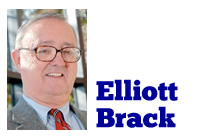 That’s what happened to one Gwinnettian seeking to visit and admire the roses at the Fernbank Museum of Natural History recently. A sign on the gate said the rose garden was closed permanently. Some of the roses moved to the Governor’s Mansion for care.
That’s what happened to one Gwinnettian seeking to visit and admire the roses at the Fernbank Museum of Natural History recently. A sign on the gate said the rose garden was closed permanently. Some of the roses moved to the Governor’s Mansion for care.
Checking with Fernbank officials, we learned that because of a withdrawal of funding by the DeKalb Board of Education to the Fernbank Science Center, back in 2012, the garden has been closed. We got that from Susan Neugent, president of Fernbank.
The DeKalb schools had paid for a professional rosarian to take care of the Robert L. Staton Rose Garden. When that professional retired, the program was discontinued, leaving Fernbank to maintain the roses.
The Garden was dedicated to Staton, a former employee of the Science Center, who loved roses. His desire to educate the public, and the absence of a test site in Atlanta’s growing climate, were key forces in the birth of the concept that evolved into the garden. At one time it was one of only three gardens in the United States that had both All-American Rose Selection and American Rose Society test roses.
The Staton Garden had been used as a test garden, to see how new cultivars would do in this area. The National Test Garden funded part of this, but this connection was discontinued in 2009.
Beds in sizes about 6×30 feet were used for the roses. There were eight professional horticulturalists in the garden at one time, plus vocational students learning how to train roses. They put in hours per bush per week. (It takes 9-11 gallons of water per bush per week.)
One Fernbank official told us “The garden was never part of the Museum; it never fell into the mission of the museum; it was just on the museum grounds. We inherited the rose garden, and were seeking a ‘good home’ to care for them.”
In April, Perk Talgo, the assistant grounds manager and the landscapist in charge of the Governor’s Mansion garden, moved 200 florabunda and hybrid tea roses to the Mansion, out of about 900 bushes in the Fernbank garden. “We picked bushes which would supplement what we already had, and used some of the Fernbank roses for accent.” So far, he reports that all the bushes have been replanted and are doing well, “because they were so healthy when we got them from Fernbank.”
One person is dedicated at the Mansion to work with the roses on a weekly basis. They provide the fertilizer, insecticide and fungicide that the roses demand. Talgo says: “You have to work closely all the time with the roses at the Mansion, and spray about every 10-15 days if you want them to thrive. You look for fungus problems and black spot. It’s the humidity in the South than requires all the care for the roses. You don’t have to put in all that care up North.”
Some of the two-thirds of the garden remaining has been given to volunteers, while other bushes not requiring heavy maintenance, mainly knock-out and spray roses, remain and are in bloom. However, they do not need the constant care other roses do.
So the big florabunda and hybrid tea roses aren’t at Fernbank any more. But visit for natural and scientific exhibits.
IN THE SPOTLIGHTFlanigan Funeral Home and Crematory
 The public spiritedness of our sponsors allows us to bring GwinnettForum.com to you at no cost to readers. Flanigan Funeral Home and Crematory is a Buford based family owned-and-operated business. We serve all faiths and offer funerals, cremations, out of town services, as well as pre-arrangements. We also accept pre-paid funeral arrangements and insurance policies that were purchased at other funeral homes. We have parking for 150 cars at our site on South Lee Street in Buford. Our dedicated and caring staff’s goal is to see that the needs of each family they serve have been met with distinctive, professional and compassionate service.
The public spiritedness of our sponsors allows us to bring GwinnettForum.com to you at no cost to readers. Flanigan Funeral Home and Crematory is a Buford based family owned-and-operated business. We serve all faiths and offer funerals, cremations, out of town services, as well as pre-arrangements. We also accept pre-paid funeral arrangements and insurance policies that were purchased at other funeral homes. We have parking for 150 cars at our site on South Lee Street in Buford. Our dedicated and caring staff’s goal is to see that the needs of each family they serve have been met with distinctive, professional and compassionate service.
- Our web site is http://www.flaniganfuneralhome.com/.
- To schedule a private appointment, please call us at 770-932-1133.
- For a list of other sponsors of this forum, go to: https://www.gwinnettforum.com/about/sponsors.htm.
Appreciates remembrance of Madison, Ga., editor
Editor, the Forum:
 Just when I think no one else can write anything better about my mother (Adelaide Wallace Ponder), I read something new. Your article was just perfect and so eloquent just like she was. I’m amazed at all the touching things I have read about her in the last few weeks.
Just when I think no one else can write anything better about my mother (Adelaide Wallace Ponder), I read something new. Your article was just perfect and so eloquent just like she was. I’m amazed at all the touching things I have read about her in the last few weeks.
I knew she was an outstanding woman but she was also my mother and she and Daddy were awesome parents. I will never forget all those great Georgia Press conventions at Jekyll and all the incredible people that Georgia was so fortunate to have in those days.
We will miss them both so much but are lucky beyond words that we had them to raise and love us in our beautiful town of Madison. Thank you for your remembrance. I will treasure it forever.
— Mary Graham Ponder Foster, St. Simons Island, Ga.
Send us a letter. We encourage readers to submit feedback (or letters to the editor). Send your thoughts to the editor at elliott@brack.net. We will edit for length and clarity. Make sure to include your name and the city where you live. Submission of a comment grants permission for us to reprint. Please keep your comments to 300 words or less. However, we will consider longer articles (no more than 500 words) for featuring in Today’s Issue as space allows.
UPCOMINGCommissioner Howard to lead major committee for ACCG
Gwinnett County Commissioner Lynette Howard was recently named as the 2015-2016 chairman of the Economic Development and Transportation Policy Committee for ACCG, Georgia’s county association. The appointment was made by ACCG President and Gwinnett County Chairman Charlotte Nash.
Legislative advocacy and public policy development are two of the primary services that ACCG provides to Georgia counties. The association uses a consensus-based policy committee process to bring together county commissioners and county staff to discuss issues of concern to county government that require changes to state and federal laws and agency policies. Policy committees develop positions on key issues, which become part of the County Platform. The County Platform is voted on by the membership at the ACCG Legislative Leadership Conference held annually in October. ACCG policy staff use the County Platform to guide advocacy efforts on behalf of counties during the legislative session.
The Economic Development and Transportation Committee covers issues ranging from transportation infrastructure and funding and the relationship between the Georgia Department of Transportation and counties to job creation, incentives for industry and other issues.
Working with Commissioner Howard on the Economic Development and Transportation Committee Policy Committee will be Jones County Commissioner Daylon Martin, who was named Vice Chairman.
Lilburn approves budget including body cameras for police
The Lilburn City Council approved the Fiscal Year 2015-2016 budget at Monday’s regular meeting. The overall budget represents a decrease of 3.1 percent from the previous fiscal year. The new budget year begins July 1.The millage rate is scheduled to be approved in the July 13 meeting, which will be a decrease from 4.45 mils to 4.43 mils.
 The FY 2015-2016 budget for all appropriated funds totals $12,914,318, which includes $6,975,353 for operations, $240,200 for the Capital Projects Fund, and $5,698,765 for the Special Purpose Local Option Sales Tax (SPLOST) Fund Issue 2009 and 2014.
The FY 2015-2016 budget for all appropriated funds totals $12,914,318, which includes $6,975,353 for operations, $240,200 for the Capital Projects Fund, and $5,698,765 for the Special Purpose Local Option Sales Tax (SPLOST) Fund Issue 2009 and 2014.
The proposed budget funds the addition of body cameras for police officers and a part-time court clerk to expedite municipal court hearings. Through budgeted SPLOST funding, the city is embarking on a new City Hall/Library project in conjunction with Gwinnett County. Also using SPLOST, the city will invest in a multi-use trail on Killian Hill Road, sidewalks in the Hillcrest area, and other trail and park enhancements.
NOTABLETwo Walton EMC directors retire, two new ones named
Two long-serving members of Walton Electric Membership Corporation’s board of directors representing parts of Gwinnett County recently announced their retirements.
Both Mary Ann Hartman of the Five Forks-North Snellville District and Bobby Williams of the Mountain Park District left office earlier this year.
Hartman has lived in Gwinnett since 1972 and was first elected to the board in 1980. Soon after election, she completed a specialized course for electric co-op board members designed to prepare them to be effective and efficient in their role.
One of Hartman’s greatest concerns is for the environment; she has always been an ardent supporter of Walton EMC’s green power efforts. During her board tenure, she held the offices of secretary/treasurer, vice chair and chair.
Dawn Taylor has been appointed to fill Hartman’s unexpired term. Taylor is an attorney who practices and lives in Lawrenceville. She is married with two children and has lived in Gwinnett County since 1997. Currently serving as president of the Brookwood Schools Foundation, Taylor has volunteered for many activities and groups in the Brookwood schools community.
Williams grew up in Mountain Park and graduated from Snellville High School in 1955. Walton EMC was just beginning to experience the boom in growth taking place in Gwinnett County when he was elected to the board in 1980.
Besides serving the Walton EMC board as secretary/treasurer, vice chair and chair, Williams also held offices on the Georgia Electric Membership Corporation and Southeastern Electrification Council boards.
Billy Ray Allen has been appointed to fill William’s unexpired term. Allen owns Brushy Forks Nursery and resides in Mountain Park. A Gwinnettian since 1971, Allen is married with five children and 11 grandchildren. Allen is an active member of the North Georgia Two-Cylinder Club.
The dirt was flying as Lilburn broke ground on City Hall-Library
The dirt was flying as the City of Lilburn and Gwinnett County broke ground on a joint City Hall-Library this week. The building is expected to open in about 14 months, and will contain 49,940 square feet, including a 24,927 square foot city hall and an 18,864 library, plus a joint entrance. The cost will be $11.3 million, partially funded by SPLOST monies.
Don’t know as we have ever seen this many people digging and shoveling at the same, all from the City of Lilburn. From left are Wayne Dubose, Sherrie Rabon, Rozalyn Schmitt, Melissa Penate, Sheila McGaughey, Hugh Wilkerson, Eddie Price, Jimi Taylor, Teresa Czuz, Norman Nash, Joellen Wilson, Doug Stacks. Bill Johnsa, Keith Cox, Nikki Perry, Bruce Hedley, and David Hibbert. (Photo by Kristen Mercer.)
Here are suggestions for safety of your children during the summer
Children’s Healthcare of Atlanta has released its 2015 Summer Safety Tips, which focus on six aspects of summer safety that parents and children can practice to ensure a safe and healthy summer. The list includes helpful advice to promote water, travel & play, sun, heat, fireworks and outdoor safety.
James Fortenberry, M.D., pediatrician-in-chief, Children’s Healthcare of Atlanta, says: “Unintentional injuries are the leading cause of death in children age 14 and under. Summer is an exciting time for kids. With that excitement comes an added responsibility for parents and children to educate themselves on what they can do to ensure a safe and healthy summer.”
Children’s has created a special section of their website dedicated to summer safety awareness. Parents can visit choa.org/summersafety to educate themselves and their children on ways to have a safe and healthy summer. The tips include:
Water Safety – Drowning is the second leading cause of unintentional death of children age 14 and under. Practicing water safety including boat, pool, swimming, life jacket and general water safety can help prevent this.
Play and Travel Safety – The summer season brings more time outside and on the road. Keep your family safe by practicing safe play and travel tips like following road rules on a bike or properly buckling your children while in the car.
Sun Safety – Melanoma, the most dangerous form of skin cancer that can spread rapidly to different parts of the body, accounts for up to three percent of pediatric cancer. Protect your kids by taking measures to prevent sunburn, and by understanding the potentially permanent effects of excessive sun exposure.
Heat Safety – Each year, young athletes and children die from heat-related illness, which is completely preventable. Know the signs of heat illness, keep kids hydrated while playing outside, and understand how to protect babies and young children from the heat.
Fireworks Safety – When it comes to fireworks safety, stick to the professionals and keep kids away. Doing so can prevent burns, the most common fireworks injury.
Outdoor Safety – Enjoying the beauty and nature of the woods is fun — if you are careful. Some things to look out for include insects, poison ivy, extreme weather or temperatures and areas where kids could trip or fall.
RECOMMENDEDAmish Confidential
A show by Levi Stoltzfus and Ellis Henican
 The Discovery Channel is known for its sensationalized series, and its most popular is Amish Mafia, which follows a group of enforcers within the Amish community of Lancaster County, Penn. ‘Lebanon Levi’ Stoltzfus controls Amish Aid, a sort of self-financed protection/assistance plan that local Amish residents and businesses fund. Levi’s book is marketed as an insiders’ view to the Amish culture, and an attempt to bring the real day-to-day lives of the Amish to light. The dichotomy of the public image marketed by Chambers of Commerce and outsider businesses portraying the Amish as ‘simple people’ (responsible for millions of tourist dollars), and the truth of who they really are, is an interesting read. In the end, we learn that the Amish community is much like the outside, with its scandals, politics, and challenges, only dressed in black suits, blue dresses, and driving horse-drawn buggies.
The Discovery Channel is known for its sensationalized series, and its most popular is Amish Mafia, which follows a group of enforcers within the Amish community of Lancaster County, Penn. ‘Lebanon Levi’ Stoltzfus controls Amish Aid, a sort of self-financed protection/assistance plan that local Amish residents and businesses fund. Levi’s book is marketed as an insiders’ view to the Amish culture, and an attempt to bring the real day-to-day lives of the Amish to light. The dichotomy of the public image marketed by Chambers of Commerce and outsider businesses portraying the Amish as ‘simple people’ (responsible for millions of tourist dollars), and the truth of who they really are, is an interesting read. In the end, we learn that the Amish community is much like the outside, with its scandals, politics, and challenges, only dressed in black suits, blue dresses, and driving horse-drawn buggies.
— Karen Burnette Garner, Dacula
An invitation: what books, restaurants, movies or web sites have you enjoyed recently? Send us your recent selection, along with a short paragraph (100 words) as to why you liked this, plus what you plan to visit or read next. –eeb
GEORGIA ENCYCLOPEDIA TIDBITTurner launches CNN, becomes major force in world television
Cable News Network (CNN) was the world’s first 24-hour cable television news channel when it was established in 1980. From its home in Atlanta, CNN has extended its reach around the world, becoming a dominant force in national and international journalism. Along with its subsidiary channels and the competitors it helped inspire, the network has changed the way information flows throughout an increasingly connected world.
CNN was founded by Georgia businessman Ted Turner. In the 1970s Turner took advantage of the increasing availability of communications satellites to begin broadcasting his independent UHF station, Atlanta’s Channel 17, which he had acquired in 1970. Rechristened WTCG to reflect the name of its new owner, Turner Communications Group, Turner’s “Superstation” began broadcasting to cable systems around the nation in 1976. (In 1979 the company’s name was changed to Turner Broadcasting System, and the station’s call letters became WTBS.)
As cable television expanded across the nation and new ventures like Home Box Office (HBO) began to show the feasibility of “niche” channels, Turner sought to create an all-news network. Working with Reese Schonfeld, a former manager for UPI Television News and the founder of the Independent Television News Association, Turner began making plans for the channel in 1978.
Plans for CNN were publicly announced in May, 1979. With the bravado that was one of his trademarks, Turner predicted that CNN would represent “the greatest achievement in the history of journalism.” Schonfeld would serve as the network’s first president and CEO. Veteran journalist Daniel Schorr, who had worked for CBS News during the “golden age” of Edward R. Murrow, lent his credibility to the venture when he agreed to become the new channel’s most visible correspondent. Turner set an ambitious goal of beginning CNN’s broadcast on June 1, 1980.
Early response was skeptical. Critics doubted whether there was a market for around-the-clock news, and many questioned whether such a venture could be profitable. In a television news universe dominated by the “big three” networks (CBS, NBC, and ABC), many wondered if there was room for such a shoestring operation, particularly one that planned to fill an enormous amount of airtime on a budget that was a fraction of what the networks spent.
Despite formidable organizational and technical obstacles (including the loss of SATCOM III, the satellite originally scheduled to carry the network’s signal), CNN managed to make its June deadline. An estimated 1.7 million cable television subscribers were able to receive the channel when it aired. Although the first day did not go without a hitch, CNN did get its first “scoop” only minutes into its inaugural broadcast, cutting away from its first commercial break to bring viewers live coverage of U.S. president Jimmy Carter‘s visit to the Fort Wayne, Indiana, hospital room of civil rights leader Vernon Jordan, who had been wounded in an assassination attempt.
Part of the concept of CNN was that the news, not the anchor, would be the star. The network’s early format, drawn in part from that of all-news radio, was centered on a news “wheel.” Major stories were repeated on a cyclical basis throughout the day, sometimes with minor modifications. New stories were added to the mix periodically. At any time, however, breaking news could arise and dominate the schedule.
- For more details on CNN’s subsequent history, click here.
- To access the Georgia Encyclopedia online, go to http://www.georgiaencyclopedia.org
Where’s this construction?
It appears to be steel, and in some intricate pattern. Now tell us where you think this piece of construction is located, and its significance. Send your entries to elliott@brack.net and be sure to include where you live.
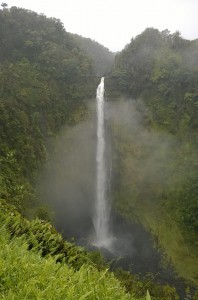 What? No one recognized the recent Mystery Photo? There’s good reason. It’s isolated. Score one for architect Rob Ponder of Duluth, who sent in this photograph of Akaka Falls at Akaka Falls State Park. It’s located way on the west side of the island of Hawaii, the big island, not far from Hilo, but far from any maddening crowd. Perhaps a few of us in Gwinnett have never even heard of this park, but Rob got a nice photo of it from a recent trip there.
What? No one recognized the recent Mystery Photo? There’s good reason. It’s isolated. Score one for architect Rob Ponder of Duluth, who sent in this photograph of Akaka Falls at Akaka Falls State Park. It’s located way on the west side of the island of Hawaii, the big island, not far from Hilo, but far from any maddening crowd. Perhaps a few of us in Gwinnett have never even heard of this park, but Rob got a nice photo of it from a recent trip there.
Some knitter
Jeannette Bain holds her American flag that she knitted before Flag Day. She is the leader of the knitting group at the Lawrenceville Senior Center. They meet every Wednesday for the knitting club and for lunch. (Photo by Frank Sharp.)
CREDITS
GwinnettForum is provided to you at no charge every Tuesday and Friday. If you would like to serve as an underwriter, click here to learn more.
- Send your thoughts, 55-word short stories, pet peeves or comments on any issue to Gwinnett Forum for future publication.
- MORE: Contact Editor and Publisher Elliott Brack at: elliott@gwinnettforum.com



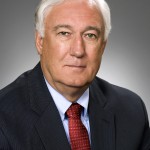
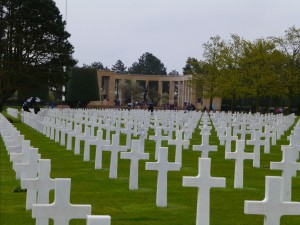
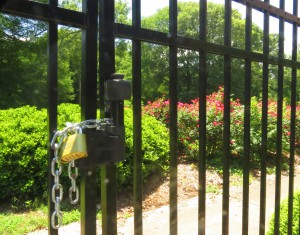

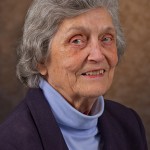

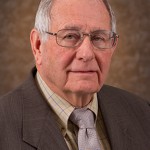
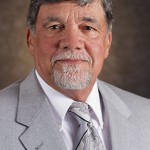

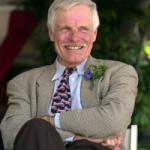

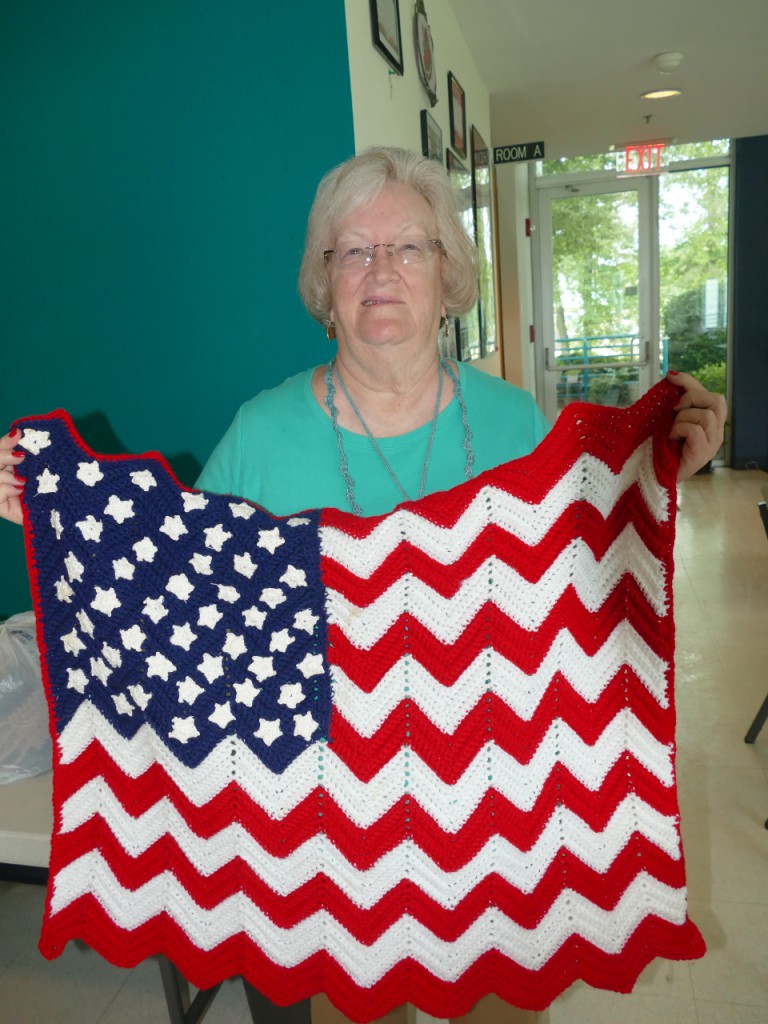







Follow Us